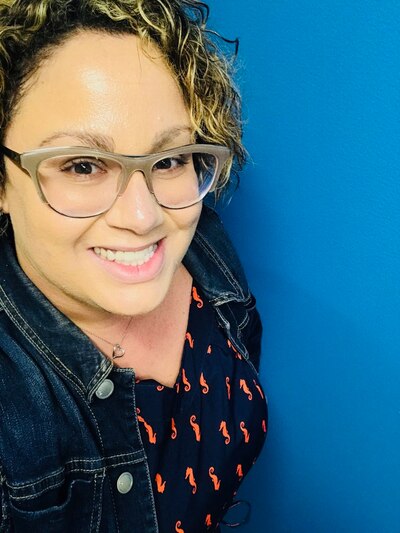Katrina Johnson was working as a special education classroom assistant in a Greater Grand Crossing school when she received an email several months ago with an intriguing proposal. Chicago Public Schools was seeking applicants for a pilot program that, in two years, would earn her full-fledged teacher status and a master’s degree.
But there was a hitch. Johnson, who’s 41, would have to juggle graduate-level courses while teaching in a classroom four days a week under a mentor teacher. And she’d be picked out of a pool of applicants to train in one of several high-poverty, “opportunity” schools — places where fewer teachers apply, and educators come and go at rates higher than the district average.
Undeterred, she put in an application. So did about 200 others for 26 positions. And in the end, CPS selected Johnson for the test run of a teacher residency pilot it plans to scale in conjunction with National Louis University and Relay Chicago’s Graduate School of Education. The latter has developed similar programs in charter schools.
Teacher residencies are the shiny new thing in education, with programs up and running in at least a dozen states. But in Illinois, where education advocates say the teacher shortage has become dire, residencies have the potential to address a host of problems, from filling critical vacancies in special education to building an on-ramp for career changers and community members who have deep ties to their neighborhood schools.
“I thought, I can’t pass this up,” said Johnson, who grew up in a family where you went either into education or the family funeral business. Johnson did neither, choosing finance and only later hearing the call of the classroom.
For career changers like her, the teaching profession can be difficult to crack despite shortages in Chicago and rural areas downstate. A sober report called Teach Illinois, shared this week with the Illinois State Board of Education, stresses that relying on traditional teacher preparation programs to crank out annual batches of freshfaced hopefuls is not enough: The statewide percentage of candidates completing teacher prep programs declined by half from 2000 to 2016.
And while school enrollment statewide is dipping, the number of teachers is declining at an even steeper rate, leaving thousands of vacancies even as students return this fall. When school started last week, 4 percent of the positions in Chicago were unfilled compared with slightly more, 5 percent, at the start of 2017, according to a district spokesman.
Like other districts, Chicago struggles to fill vacancies in special education and bilingual instruction. It also is challenged to find and retain diverse candidates. The residency pilot presents an opportunity there, too. Of the initial 26 Chicago residents, 20 identify as persons of color, according to CPS.
Matt Lyons, CPS’ chief talent officer, said the first cohort drew primarily from paraprofessionals, special-education assistants, and other people who’ve been working in Chicago schools; only a handful came from the community. “There was far more interest among our current employees than we anticipated,” he said.
But as the program grows, he expects it could draw more broadly from the communities around the district’s highest-need schools — another strategy that education experts are hopeful can quell turnover in high-poverty districts.
“Let’s think about how school districts have typically acquired talent,” said Kent Fischer, the communications director for the National Center for Teaching Residencies, which is based in Chicago. “They put out an online notice. Go to college and job fairs. Collect resumes that come in and sift through them. The residency model flips that and puts the school district in charge of creating its own talent pipeline.”
***
Chicago has big plans for its teacher residency pilot, which so far works this way: Residents start master’s-level courses over the summer, then apprentice in classrooms the first year alongside a master teacher. They teach Monday through Thursday and attend grad courses on Fridays and in some evenings, depending on the program. The second year, they teach on a provisional license and finish their coursework and specialty endorsements to earn the master’s.
The first year of the pilot has no strings. But for the 2019-20 class (for which applications are currently open), residents must agree to stay with the district for two years.
“The goal is to grow the program to 60 then to 80 then to 100 in three years,” said Lyons, whose pilot group is currently concentrated in 14 Chicago schools.
Fischer, from the national center, points to early research that shows retention rates above 80 percent among grads from residency programs, compared with closer to half from traditional programs. That stat is welcome news to talent officers like Lyons. “When we looked at the data of the 50 hardest-to-staff schools, they experienced two times as much turnover and were two times as likely to start the school year with vacancies” than the district as a whole, he said.
Residencies, he acknowledged, are but one strategy to address the problem. The district is hiring earlier than usual at its 50 opportunity schools, staffing them with teacher coaches, and building an exclusive professional development program for staff.
Despite all the potential, it’s too early to definitively call residency programs a categorical success. They are costly to establish, and costly to maintain. There’s also conflicting research about how adequately they prepare teachers.
Chicago pays each participant an initial stipend of $35,000, but that’s not enough to cover living expenses plus tuition. There are grants that can chip away at the cost for those who qualify, but some participants have to take out loans to fund tuition.

The stipend doesn’t fully cover Yesenia Francois’ tuition at National Louis, but she’s still “forever grateful.” A resident this year in a bilingual first-grade classroom at Marvin Camras Children’s Engineering School in Belmont-Cragin, Francois, 37, gets a discounted rate at NLU, she says, and she’s on a three-part payment plan.
A former paraprofessional at a North Side magnet school, she’s fine with that — she stresses the opportunity to fast-track her career, boost her earning potential, and finally get the master’s degree she’s been trying to earn for a decade, while practically having a job guaranteed on the other side. Her son has special needs, and the responsibility of caring for him has twice derailed her education. This time, it feels different, she says.
“I’m like a sponge,” she said. “As a paraprofessional, I supported diverse learners, but there was a general-education teacher who laid the foundation. As a resident, I’m working with a mentor and starting from scratch. I’m building the lessons and adding in these layers. I have ownership.”
***
Unlike other cities that have relied solely on philanthropy to foot the bill, Lyons said Chicago’s program is designed to be sustainable, with a portion coming from CPS in combination with a federal grant and a small group of philanthropies. “We’re cognizant that we are building something,” he said, “and we want to be intentional about it.”
The other crucial ingredient is cooperation from a traditional teacher prep program, one aspect of the residency model that could limit adoption by districts in, say, more rural areas that don’t have access to colleges.
Chicago split its pilot group into two, with bilingual teachers attending classes at National Louis University, which is building something similar in East St. Louis, and special education teachers going through Relay Chicago.
Janet Lorch, the resident program director at National Louis, thought carefully about how to refashion her general curriculum to fit into summers and Fridays, when resident teachers were available for classes. She stresses building off actual experiences — one assignment, for example, requires residents to organize a family engagement event at the school. She also places high importance on coaching mentor teachers.
“Instead of a traditional (teacher prep) supervisor going in and saying something, like, you need to smile more, we go in and work with the mentor teacher so there is recursive feedback role. There’s a core practice of modeling — we spend time talking to mentors about that.”
Robert Muller, the dean of the College of Education at National Louis, said professors want to guard against burnout. After all, the teacher hopefuls can end up fried by the prospect of the dueling demands of graduate school and their day jobs. That’s where a four-day program design — four days in the CPS classrooms, with Friday as a day at NLU — appears to ease the pressure.
“It’s the design here that is powerful. It’s practice, theory, practice, theory. In some ways, what we do with residencies could inform our more traditional program.”
In fact, it’s Fridays that Yesenia Francois looks forward to — and not just because TGIF. She says her cohort, which started its classes over the summer, has formed an intense bond that extends to chat sessions midweek over group texts. “We’ll share if we have a successful lesson or an experience with a book or video,” she said. “It’s like an extended family.”
Recently, one NLU resident heard about an organization that was giving away classroom supplies. That resident shared it with Francois and the others, and the request snowballed. Just like that, the residents were able to do something good for a district that’s investing in them.

